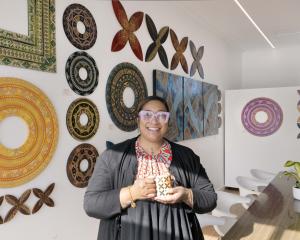In the early 1800s, British society women eagerly anticipated the arrival each month of The Repository of Arts, Literature, Commerce, Fashion and Politics, which kept them up to date with what was going on in the world.
Besides finding out what Napoleon was doing, and reading of the latest ideas about art, philosophy and science, travel, architecture or furnishings, they also learned indispensable fashion information, such as that matrons preferred pelisses this season, whereas spencers were the order of the day for young belles.
More recently, the plates in Rudolph Ackerman's Repository of Arts have been a valuable resource for people re-creating the Regency period, such as dramatising Jane Austen's novels, according to Lynda Cullen.
She has curated "A la Mode" an exhibition of Ackerman's fashion plates from the Dunedin Public Art Gallery's collection, which opens on Saturday.
The 45 detailed, hand-coloured plates from about 1811 to 1825 were given to the gallery in the 1960s by Margaret Middleditch, who lived in Rye in Sussex, UK.
They show a variety of fashionable garments including morning dress, carriage dress, garden and promenade costumes, evening, ball, opera and even a wedding dress.
Fashions reflect the cultural influences of the time.
In this case, it was the influence of the French Revolution in 1789, the Napoleonic Wars from the beginning of the 19th century until 1815, the neoclassical concern with ancient Greece and Rome, justice and enlightenment, the Romantic movement, and its enthusiasm for the perceived innocence of nature, she said.
During the French Revolution, people started dressing more simply as a reaction to the artificiality of the previous period, which had included hooped skirts, high hairstyles and heavy makeup.
Napoleon's wife Josephine introduced the empire line, with the waist high under the bust and his exploits in the Eastern Mediterranean brought exotic ideas, such as Turkish tunics and turbans into fashion, Ms Cullen said.
The 18th-century French philosopher Jean Jacques Rousseau's argument that civilisation had corrupted our natural goodness and curtailed our freedom, led to a move back to nature, and the Romantic movement.
Children were no longer considered miniature adults and dressed as such, but seen as innocent and individual.
Women, too, were encouraged to breast-feed their children instead of employing a wet nurse, and ideas that women could be educated so they could educate their sons led to early advocates for women's rights, such as Mary Woolstoncraft.
In A Vindication of the Rights of Woman (1792), she argues that women are not naturally inferior to men, but appear to be only because they lack education.
She suggests that both men and women should be treated as rational beings and imagines a social order founded on reason.
"I always find a certain ambivalence when you change to a fashion that appears to be suffrage or women's rights oriented. Somehow it has this other undercurrent. Think of the mini [of the 1960s], for example. In some ways, it was really debilitating because you couldn't bend down, so you lost that freedom," Ms Cullen said.
In the early 19th century women wore muslin dresses even in winter and suffered chills and pneumonia, and some of Hogarth's comic illustrations showed women's dresses blowing revealingly against them in the wind.
Although dresses might be simpler than in earlier periods, corsets were still worn, although they were less constricting than 18th-century stays.
Women were well covered during the day, but evening dresses had low decolletages revealing the bosom, she said.
At the same time, gloves were worn to cover hands and arms.
In the second and third decades of the 19th century, as the Regency period passed, women's clothing became more structured and elaborate, the waist lowered, and by mid-century there was the idea of women as helpless, decorative angels, followed by the reintroduction of hooped petticoats in the Victorian crinoline.
See it
"A la Mode: Early 19th century fashion plates from the collection" starts on Saturday at the Dunedin Public Art Gallery and runs until July 10.











